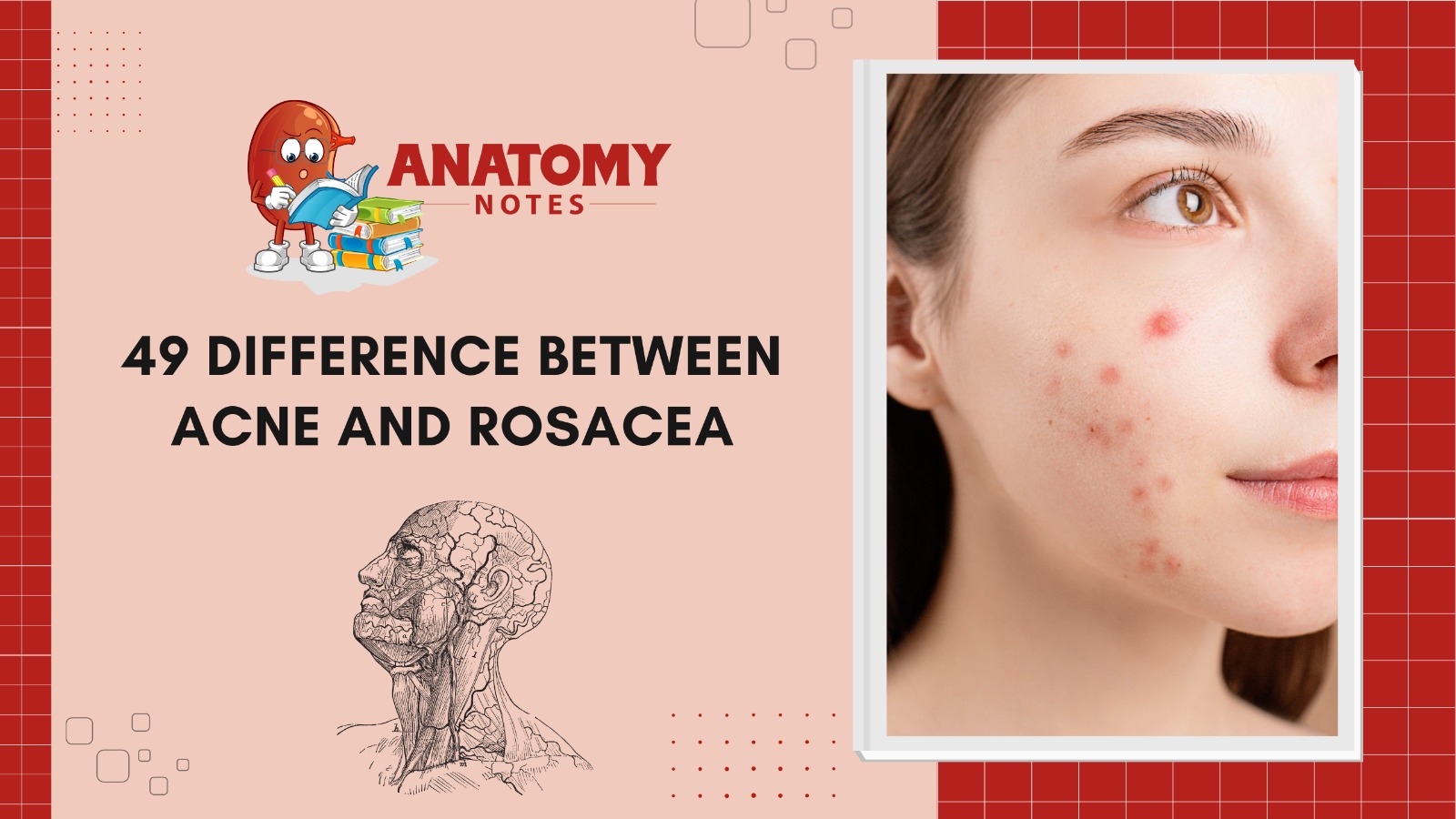Acne and rosacea are prevalent skin illnesses with similar symptoms but differing causes and physical features. Knowing how these diseases vary helps diagnose and treat them. Doctors term acne vulgaris, which mainly affects teenagers and young adults. Oil and dead skin cells lodged in hair shafts cause pimples, blackheads, whiteheads, and, in the worst instances, masses and cysts. Hormones, oil production, bacteria (Propionibacterium acnes), and genetics cause acne. It might be minor or severe, appearing on the face, chest, and back. Creams, oral antibiotics, hormones, and isotretinoin can treat acne.
Rosacea, a long-term skin disorder that produces inflammation, mainly affects persons over 30. Rosacea often makes the cheeks, nose, and forehead red, flushed, and displays blood vessels. Rosacea doesn’t cause comedones. It can create acne-like papules and pustules. Genes, irregular blood vessel function, sun, alcohol, spicy meals, and stress can worsen rosacea, which has an unknown etiology. Rosacea symptoms and causes are addressed. Topicals, oral antibiotics, lasers, and lifestyle modifications can achieve this.
Acne occurs around adolescence and improves with age, but rosacea is a long-term illness that can worsen if untreated. Rosacea can cause dryness, irritation, and redness in the eyes. Not acne.
In conclusion, acne and rosacea both create spots and redness, but they are separate illnesses with different origins and symptoms. Rosacea causes redness, flushing, and facial blood vessels, whereas acne is caused by hormonal changes and blocked pores. Environment and lifestyle often cause it. A dermatologist must properly assess these problems to treat and manage them.
Also Read: A History of Anatomy From the Beginning to the Present
|
S. No. |
Aspect |
Acne |
Rosacea |
|
1 |
Skin Area Affected |
Face, chest, back, shoulders |
Primarily affects the central face area |
|
2 |
Age of Onset |
Typically starts in puberty |
Often develops in adulthood |
|
3 |
Lesion Types |
Comedones, pimples, cysts |
Redness, visible blood vessels, papules, pustules |
|
4 |
Inflammation |
Inflammatory and non-inflammatory lesions |
Predominantly inflammatory |
|
5 |
Triggers |
Hormonal changes, bacteria, oil |
Triggers often include sunlight, heat, certain foods |
|
6 |
Comedones (Blackheads, Whiteheads) |
Common |
Absent |
|
7 |
Severity |
Ranges from mild to severe |
Varies from mild to severe |
|
8 |
Acne Scarring |
Can cause scarring and hyperpigmentation |
Generally does not cause scarring |
|
9 |
Genetic Factors |
Genetics can play a role |
Genetic factors may contribute |
|
10 |
Hormonal Influence |
Hormonal changes can worsen acne |
Not as closely linked to hormonal changes |
|
11 |
Flare-Ups |
Can occur due to various triggers |
Often triggered by specific factors |
|
12 |
Bacterial Involvement |
Bacteria (Propionibacterium acnes) play a role |
Not primarily caused by bacteria |
|
13 |
Popping Lesions |
Can lead to worsened inflammation |
Not recommended, can exacerbate symptoms |
|
14 |
Treatment Approach |
Topical and oral medications, skincare |
Medications, lifestyle changes, skincare |
|
15 |
Tendency for Redness |
Redness often localized around lesions |
|
|
16 |
Eye Involvement |
Typically does not involve the eyes |
Ocular rosacea can affect the eyes |
|
17 |
Psychosocial Impact |
Can impact self-esteem and mental health |
Can lead to self-consciousness and distress |
|
18 |
Age Group Affected |
Adolescents and adults affected |
Primarily adults, especially 30-50 years |
|
19 |
Lesion Appearance |
Pustules, papules, whiteheads, blackheads |
Papules, pustules, visible blood vessels |
|
20 |
Rosacea Subtypes |
Not relevant |
Four main subtypes: erythematotelangiectatic, papulopustular, phymatous, ocular |
|
21 |
Emotional Impact |
Can have psychological effects |
Emotional distress can be significant |
|
22 |
Skin Texture Changes |
Possible due to scarring or inflammation |
Skin may appear thicker or rougher |
|
23 |
Sunlight Sensitivity |
Typically not a major factor |
Often worsens symptoms in some cases |
|
24 |
Triggers for Flare-Ups |
Hormonal fluctuations, stress, diet |
Specific triggers like sunlight, heat, certain foods |
|
25 |
Onset Pattern |
Gradual onset during adolescence |
Gradual onset, more common in adults |
|
26 |
Management Approach |
Addressing oil production, bacteria, inflammation |
Reducing inflammation, triggers |
|
27 |
Severity Progression |
Can worsen or improve over time |
May progress to more severe forms |
|
28 |
Medication Classes |
Antibiotics, retinoids, benzoyl peroxide |
Topical and oral medications |
|
29 |
Physical Discomfort |
Can be painful due to inflamed lesions |
May include burning or stinging |
|
30 |
Redness Patterns |
Primarily around lesions |
More widespread redness |
|
31 |
Affects Blood Vessels |
Not a primary characteristic |
Prominent in certain rosacea subtypes |
|
32 |
Comedone Formation |
Common, especially in moderate-severe acne |
Not a defining feature |
|
33 |
Self-Care Measures |
Proper skincare important |
Avoiding triggers, gentle skincare |
|
34 |
Pimple Types |
Various types due to inflammation |
Pustules and papules are common |
|
35 |
Scalp Involvement |
Can affect the scalp |
Primarily affects the face |
|
36 |
Hair Follicle Involvement |
Common due to inflammation |
Not a defining feature |
|
37 |
Psychological Impact |
Can impact self-confidence |
Can lead to self-consciousness |
|
38 |
Cold Weather Aggravation |
Can worsen symptoms |
Cold weather may exacerbate symptoms |
|
39 |
Lesion Presence |
Various types of lesions present |
Primarily redness and papules/pustules |
|
40 |
Dermatologist Involvement |
Often recommended for diagnosis and treatment |
Diagnosis and management by dermatologist |
|
41 |
Flare-Up Duration |
Variable, can last days to weeks |
Variable, may last longer in some cases |
|
42 |
Acne Mechanisms |
Hyperactivity of sebaceous glands |
Inflammation and blood vessel dilation |
|
43 |
Rosacea Mechanisms |
Inflammation and blood vessel dilation |
Various factors contribute to rosacea |
|
44 |
Impact on Makeup Application |
Can make application challenging |
Redness and texture can impact makeup application |
|
45 |
Association with Systemic Diseases |
Not commonly associated with other diseases |
May have associations with other conditions |
|
46 |
Genetic Predisposition |
Genetics can play a role |
Genetic factors may contribute |
|
47 |
Emotional Distress |
Can cause emotional distress |
Can lead to embarrassment and distress |
|
48 |
Treatment Duration |
Can vary, may require long-term management |
Long-term management often necessary |
|
49 |
Dermatological Procedures |
May involve acne extraction or laser therapy |
Procedures can be used for redness, blood vessels |
Also Read: Structure of skin; A Creature of Epidermis, Dermis and Hypodermis
Frequently Asked Questions (FAQS)
Q1. What is the main difference between acne and rosacea?
Acne and rosacea cause facial redness and blemishes. Their root causes and traits distinguish them. Excess oil, blocked pores, and bacterial inflammation produce acne, which typically affects teens and young adults. Rosacea, a chronic inflammatory disorder affecting adults, causes redness, visible blood vessels, and acne-like pimples.
Q2. Are acne and rosacea alike?
Due to their similar symptoms, acne and rosacea might be confused. Dermatologists must distinguish between the two disorders because treatments vary. Rosacea may need blood vessel or inflammation-targeting medications, while acne is usually treated with antibiotics and retinoids.
Q3. What causes acne and rosacea outbreaks?
Acne and rosacea triggers exist. Hormones, skincare products, and a high-sugar or dairy diet can aggravate acne. Sunlight, stress, spicy meals, alcohol, and severe temperatures can cause rosacea. Avoiding these factors can improve both diseases.
Q4. Can I use the same skincare products for acne and rosacea?
Choose skincare products wisely based on your situation. Acne products may irritate and redden rosacea-prone skin. Rosacea patients should use moderate, non-comedogenic, fragrance-free products. A dermatologist can customize your skincare routine.
Q5. Can lifestyle changes help with managing acne and rosacea?
Lifestyle changes can help treat acne and rosacea. A regular skincare regimen with non-irritating products, UV protection, and a balanced diet rich in antioxidants and anti-inflammatory foods can help both diseases. Avoiding spicy foods, alcohol, and stress, and applying a broad-spectrum sunscreen every day is crucial for rosacea.




